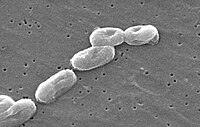
Photo from wikipedia
The Tier 1 HHS/USDA Select Agent Burkholderia pseudomallei is a bacterial pathogen that is highly virulent when introduced into the respiratory tract and intrinsically resistant to many antibiotics. Transcriptomic- and… Click to show full abstract
The Tier 1 HHS/USDA Select Agent Burkholderia pseudomallei is a bacterial pathogen that is highly virulent when introduced into the respiratory tract and intrinsically resistant to many antibiotics. Transcriptomic- and proteomic-based methodologies have been used to investigate mechanisms of virulence employed by B. pseudomallei and Burkholderia thailandensis, a convenient surrogate; however, analysis of the pathogen and host metabolomes during infection is lacking. Changes in the metabolites produced can be a result of altered gene expression and/or post-transcriptional processes. Thus, metabolomics complements transcriptomics and proteomics by providing a chemical readout of a biological phenotype, which serves as a snapshot of an organism's physiological state. However, the poor signal from bacterial metabolites in the context of infection poses a challenge in their detection and robust annotation. In this study, we coupled mammalian cell culture-based metabolomics with feature-based molecular networking of mono- and co-cultures to annotate the pathogen's secondary metabolome during infection of mammalian cells. These methods enabled us to identify several key secondary metabolites produced by B. thailandensis during infection of airway epithelial and macrophage cell lines. Additionally, the use of in silico approaches provided insights into shifts in host biochemical pathways relevant to defense against infection. Using chemical class enrichment analysis, for example, we identified changes in a number of host-derived compounds including immune lipids such as prostaglandins, which were detected exclusively upon pathogen challenge. Taken together, our findings indicate that co-culture of B. thailandensis with mammalian cells alters the metabolome of both pathogen and host and provides a new dimension of information for in-depth analysis of the host-pathogen interactions underlying Burkholderia infection.
Journal Title: ACS infectious diseases
Year Published: 2022
Link to full text (if available)
Share on Social Media: Sign Up to like & get
recommendations!